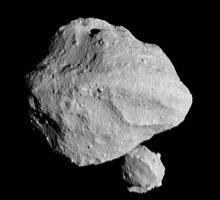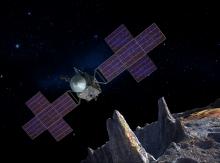Listen to today's episode of StarDate on the web the same day it airs in high-quality streaming audio without any extra ads or announcements. Choose a $8 one-month pass, or listen every day for a year for just $30.
You are here
Moon and Regulus
What happens in the asteroid belt doesn’t necessarily stay in the asteroid belt. In fact, Earth and the Moon might be feeling the effects of actions in the belt hundreds of millions of years ago.
The asteroid belt is a wide band of rocky debris between the orbits of Mars and Jupiter. On average, the big space rocks are widely separated. Every once in a while, though, two of them collide. That can shatter one or both bodies, creating more debris. And if the impact happens at the right location, the debris can skitter toward the inner solar system. Once here, the chips can hit Earth and the Moon, blasting new craters.
A recent study found that the debris from such an asteroid collision might have started bombarding Earth and the Moon almost 300 million years ago.
It’s hard to count the craters on Earth because they’re altered by wind, rain, and the motions of Earth’s crust. But Earth and the Moon get hit by the same wave of material. So researchers counted craters on the Moon. In particular, they looked for craters that were big but young.
They found that the rate of crater formation jumped by a factor of more than two and a half about 290 million years ago. One possible explanation for that is one or more collisions in the asteroid belt — events that are having a big impact on Earth and the Moon.
Look for the Moon high in the sky at first light tomorrow. The bright star Regulus, the heart of the lion, will stand below it.





